Ortiz de Montellano Paul R.(Ed.) Cytochrome P450. Structure, Mechanism, and Biochemistry
Подождите немного. Документ загружается.

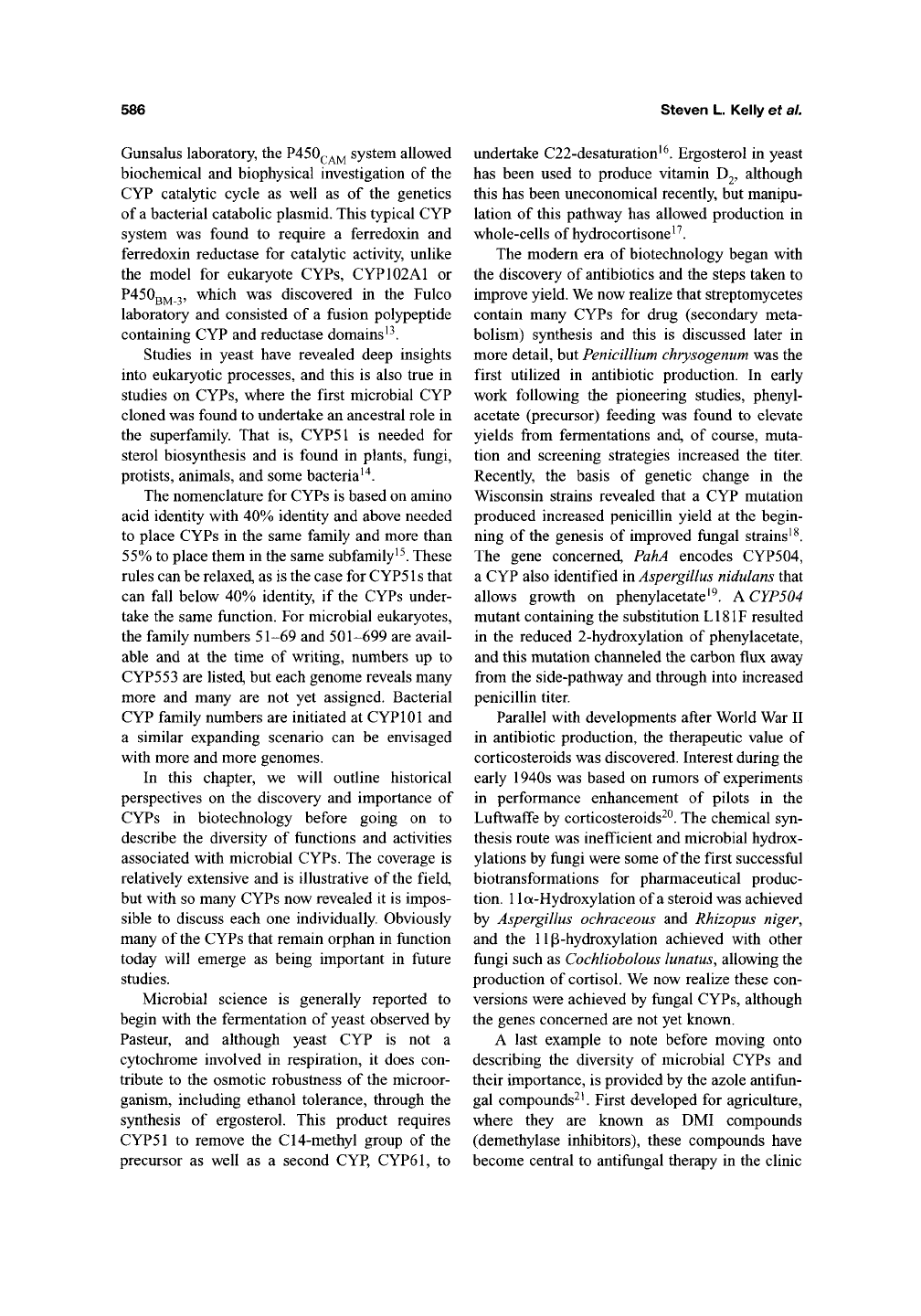
586
Steven L. Kelly et al.
Gunsalus laboratory, the P450(^^j^ system allowed
biochemical and biophysical investigation of the
CYP catalytic cycle as well as of the genetics
of
a
bacterial catabolic plasmid. This typical CYP
system was found to require a ferredoxin and
ferredoxin reductase for catalytic activity, unlike
the model for eukaryote CYPs, CYP 102A1 or
P450gj^
3,
which was discovered in the Fulco
laboratory and consisted of a fusion polypeptide
containing CYP and reductase domains'^.
Studies in yeast have revealed deep insights
into eukaryotic processes, and this is also true in
studies on CYPs, where the first microbial CYP
cloned was found to undertake an ancestral role in
the superfamily That is, CYP51 is needed for
sterol biosynthesis and is found in plants, fungi,
protists, animals, and some bacteria^'^.
The nomenclature for CYPs is based on amino
acid identity with 40% identity and above needed
to place CYPs in the same family and more than
55%
to place them in the same subfamily^^. These
rules can be relaxed, as is the case for CYP51s that
can fall below 40% identity, if the CYPs under-
take the same function. For microbial eukaryotes,
the family numbers 51-69 and 501-699 are avail-
able and at the time of writing, numbers up to
CYP553 are listed, but each genome reveals many
more and many are not yet assigned. Bacterial
CYP family numbers are initiated at CYPlOl and
a similar expanding scenario can be envisaged
with more and more genomes.
In this chapter, we will outline historical
perspectives on the discovery and importance of
CYPs in biotechnology before going on to
describe the diversity of functions and activities
associated with microbial CYPs. The coverage is
relatively extensive and is illustrative of the field,
but with so many CYPs now revealed it is impos-
sible to discuss each one individually. Obviously
many of the CYPs that remain orphan in function
today will emerge as being important in future
studies.
Microbial science is generally reported to
begin with the fermentation of yeast observed by
Pasteur, and although yeast CYP is not a
cytochrome involved in respiration, it does con-
tribute to the osmotic robustness of the microor-
ganism, including ethanol tolerance, through the
synthesis of ergosterol. This product requires
CYP51 to remove the C14-methyl group of the
precursor as well as a second CYP,
CYP61,
to
undertake C22-desaturation^^. Ergosterol in yeast
has been used to produce vitamin D2, although
this has been uneconomical recently, but manipu-
lation of this pathway has allowed production in
whole-cells of hydrocortisone^^.
The modern era of biotechnology began with
the discovery of antibiotics and the steps taken to
improve yield. We now realize that streptomycetes
contain many CYPs for drug (secondary meta-
bolism) synthesis and this is discussed later in
more detail, but Penicillium chrysogenum was the
first utilized in antibiotic production. In early
work following the pioneering studies, phenyl-
acetate (precursor) feeding was found to elevate
yields from fermentations and, of course, muta-
tion and screening strategies increased the titer.
Recently, the basis of genetic change in the
Wisconsin strains revealed that a CYP mutation
produced increased penicillin yield at the begin-
ning of the genesis of improved fungal strains^^.
The gene concerned, PahA encodes CYP504,
a CYP also identified in Aspergillus nidulans that
allows growth on phenylacetate'^. A CYP504
mutant containing the substitution LI8IF resulted
in the reduced 2-hydroxylation of phenylacetate,
and this mutation channeled the carbon flux away
from the side-pathway and through into increased
penicillin titer.
Parallel with developments after World War II
in antibiotic production, the therapeutic value of
corticosteroids was discovered. Interest during the
early 1940s was based on rumors of experiments
in performance enhancement of pilots in the
Luftwaffe by corticosteroids^^. The chemical syn-
thesis route was inefficient and microbial hydrox-
ylations by fungi were some of the first successful
biotransformations for pharmaceutical produc-
tion.
1
la-Hydroxylation of a steroid was achieved
by Aspergillus ochraceous and Rhizopus niger,
and the
11
p-hydroxylation achieved with other
fungi such as Cochliobolous lunatus, allowing the
production of
Cortisol.
We now realize these con-
versions were achieved by fungal CYPs, although
the genes concerned are not yet known.
A last example to note before moving onto
describing the diversity of microbial CYPs and
their importance, is provided by the azole antifun-
gal compounds^ ^ First developed for agriculture,
where they are known as DMI compounds
(demethylase inhibitors), these compounds have
become central to antifungal therapy in the clinic
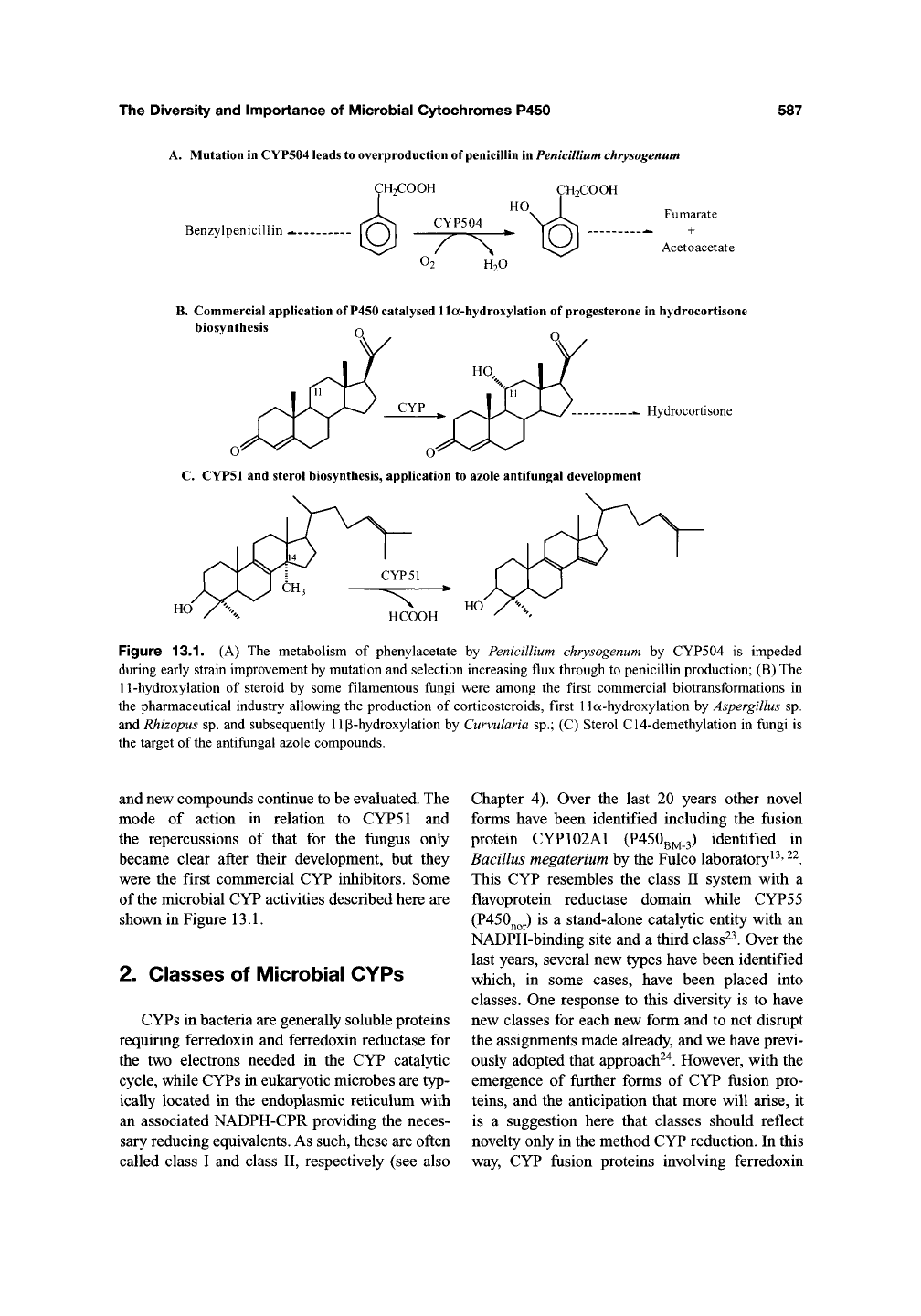
The Diversity and Importance of IViicrobial Cytochromes P450 587
A. Mutation
in
CYP504 leads to overproduction of penicillin
in Penicillium
chrysogenum
CH2COOH CH2COOH
I
HO I
Benzylpenicillin -.
_CYP504
O2 H2O
Fumarate
+
Acetoacetate
B.
Commercial application of P450 catalysed lla-hydroxylation of progesterone in hydrocortisone
biosynthesis Q
-- Hydrocortisone
C.
CYP51 and sterol biosynthesis, application to azole antifungal development
HCOOH
Figure 13.1. (A) The metabolism of phenylacetate by Penicillium chrysogenum by CYP504 is impeded
during early strain improvement by mutation and selection increasing flux through to penicillin production; (B) The
11-hydroxylation of steroid by some filamentous fungi were among the first commercial biotransformations in
the pharmaceutical industry allowing the production of corticosteroids, first lla-hydroxylation by Aspergillus sp.
and Rhizopus sp. and subsequently
11
P-hydroxylation by Curvularia sp.; (C) Sterol C14-demethylation in fungi is
the target of the antifungal azole compounds.
and new compounds continue to be evaluated. The
mode of action in relation to CYP51 and
the repercussions of that for the fungus only
became clear after their development, but they
were the first commercial CYP inhibitors. Some
of the microbial CYP activities described here are
shown in Figure 13.1.
2.
Classes of Microbial CYPs
CYPs in bacteria are generally soluble proteins
requiring ferredoxin and ferredoxin reductase for
the two electrons needed in the CYP catalytic
cycle, while CYPs in eukaryotic microbes are typ-
ically located in the endoplasmic reticulum with
an associated NADPH-CPR providing the neces-
sary reducing equivalents. As such, these are often
called class I and class II, respectively (see also
Chapter 4). Over the last 20 years other novel
forms have been identified including the fusion
protein CYP102A1 (P450gj^_3) identified in
Bacillus megaterium by the Fulco laboratory^^'
^^.
This CYP resembles the class II system with a
flavoprotein reductase domain while CYP55
(P450j^Qj.) is a stand-alone catalytic entity with an
NADPH-binding site and a third class^^. Over the
last years, several new types have been identified
which, in some cases, have been placed into
classes. One response to this diversity is to have
new classes for each new form and to not disrupt
the assignments made already, and we have previ-
ously adopted that approach^^. However, with the
emergence of further forms of CYP fusion pro-
teins,
and the anticipation that more will arise, it
is a suggestion here that classes should reflect
novelty only in the method CYP reduction. In this
way, CYP fUsion proteins involving ferredoxin
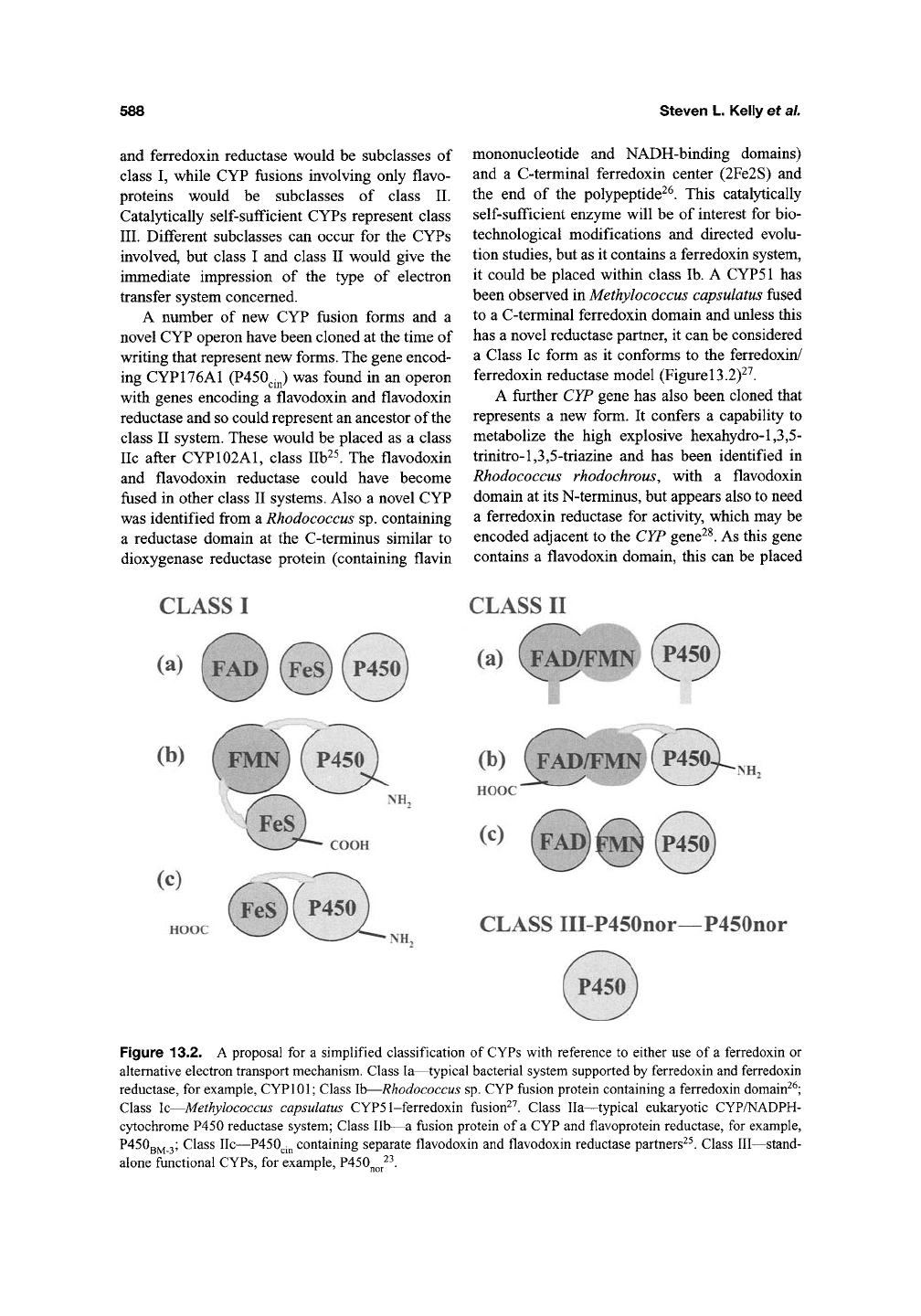
588
Steven L. Kelly et al.
and ferredoxin reductase would be subclasses of
class I, while CYP fusions involving only flavo-
proteins would be subclasses of class II.
Catalytically self-sufficient CYPs represent class
III.
Different subclasses can occur for the CYPs
involved, but class I and class II would give the
immediate impression of the type of electron
transfer system concerned.
A number of new CYP fusion forms and a
novel CYP operon have been cloned at the time of
writing that represent new forms. The gene encod-
ing CYP176A1 (P450^.j^) was found in an operon
with genes encoding a flavodoxin and flavodoxin
reductase and so could represent an ancestor of the
class II system. These would be placed as a class
lie after CYP102A1, class Ilb^^. The flavodoxin
and flavodoxin reductase could have become
fused in other class II systems. Also a novel CYP
was identified from a Rhodococcus sp. containing
a reductase domain at the C-terminus similar to
dioxygenase reductase protein (containing flavin
mononucleotide and NADH-binding domains)
and a C-terminal ferredoxin center (2Fe2S) and
the end of the polypeptide^^. This catalytically
self-sufficient enzyme will be of interest for bio-
technological modifications and directed evolu-
tion studies, but as it contains a ferredoxin system,
it could be placed within class lb. A CYP51 has
been observed in Methylococcus capsulatus fused
to a C-terminal ferredoxin domain and unless this
has a novel reductase partner, it can be considered
a Class Ic form as it conforms to the ferredoxin/
ferredoxin reductase model (Figure
13.2)^^.
A further CYP gene has also been cloned that
represents a new form. It confers a capability to
metabolize the high explosive hexahydro-1,3,5-
trinitro-l,3,5-triazine and has been identified in
Rhodococcus rhodochrous, with a flavodoxin
domain at its N-terminus, but appears also to need
a ferredoxin reductase for activity, which may be
encoded adjacent to the CYP gene^^. As this gene
contains a flavodoxin domain, this can be placed
CLASS I
(a)
(b)
(c)
HOOC
(^^NH.
(b)
HOOC
(c)
CLASS ni-P450nor—P450nor
Figure 13.2. A proposal for a simplified classification of CYPs with reference to either use of a ferredoxin or
alternative electron transport mechanism. Class la—^typical bacterial system supported by ferredoxin and ferredoxin
reductase, for example, CYPlOl; Class lb—Rhodococcus sp. CYP fusion protein containing a ferredoxin domain^^;
Class Ic—Methylococcus capsulatus CYPS
1-ferredoxin
fusion^^. Class Ila—^typical eukaryotic CYP/NADPH-
cytochrome P450 reductase system; Class lib—a fusion protein of a CYP and flavoprotein reductase, for example,
P450gj^
3;
Class lie—P450^-j^ containing separate flavodoxin and flavodoxin reductase partners-^^. Class III—stand-
alone functional CYPs, for example, P450j^^j.^^.
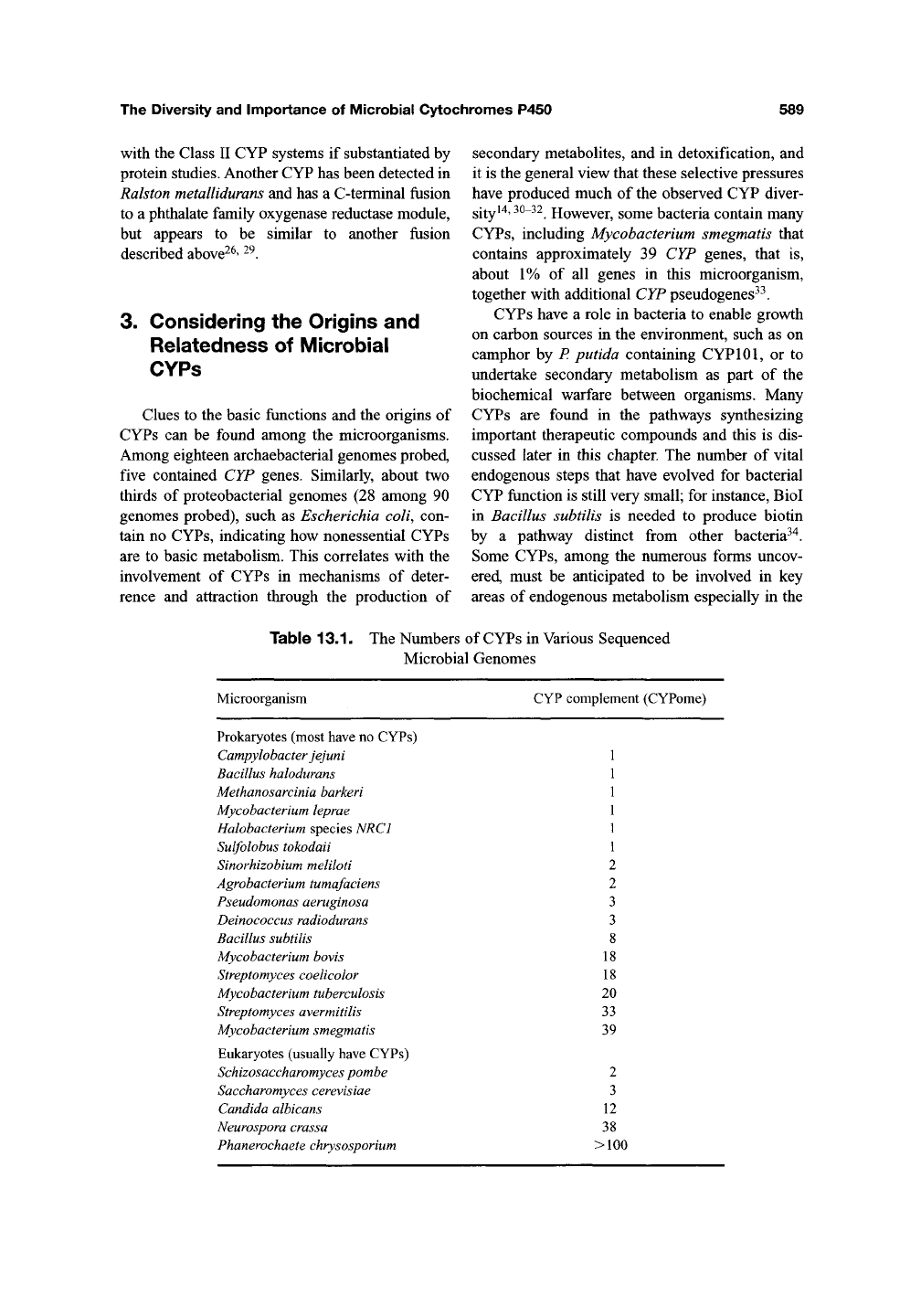
The Diversity and Importance of IVIicrobial Cytochromes P450
589
with the Class II CYP systems if substantiated by
protein studies. Another CYP has been detected in
Ralston metallidurans and has a C-terminal fusion
to a phthalate family oxygenase reductase module,
but appears to be similar to another fusion
described above^^' ^^.
3. Considering the Origins and
Relatedness of Microbial
CYPs
Clues to the basic functions and the origins of
CYPs can be found among the microorganisms.
Among eighteen archaebacterial genomes probed,
five contained CYP genes. Similarly, about two
thirds of proteobacterial genomes (28 among 90
genomes probed), such as Escherichia coli, con-
tain no CYPs, indicating how nonessential CYPs
are to basic metabolism. This correlates with the
involvement of CYPs in mechanisms of deter-
rence and attraction through the production of
secondary metabolites, and in detoxification, and
it is the general view that these selective pressures
have produced much of the observed CYP diver-
gjlyi4,30-32 However, some bacteria contain many
CYPs, including Mycobacterium smegmatis that
contains approximately 39 CYP genes, that is,
about 1% of all genes in this microorganism,
together with additional CYP pseudogenes^^.
CYPs have a role in bacteria to enable growth
on carbon sources in the environment, such as on
camphor by P putida containing CYPlOl, or to
undertake secondary metabolism as part of the
biochemical warfare between organisms. Many
CYPs are found in the pathways s)aithesizing
important therapeutic compounds and this is dis-
cussed later in this chapter. The number of vital
endogenous steps that have evolved for bacterial
CYP function is still very small; for instance, Biol
in Bacillus subtilis is needed to produce biotin
by a pathway distinct from other bacteria^"*.
Some CYPs, among the numerous forms uncov-
ered, must be anticipated to be involved in key
areas of endogenous metabolism especially in the
Table 13.1. The Numbers of CYPs in Various Sequenced
Microbial Genomes
Microorganism CYP complement (CYPome)
Prokaryotes (most have no CYPs)
Campylobacter jejun i
Bacillus halodurans
Methanosarcinia barkeri
Mycobacterium leprae
Halobacterium species NRCl
Sulfolobus tokodaii
Sinorhizobium meliloti
Agrobacterium tumafaciens
Pseudomonas aeruginosa
Deinococcus radiodurans
Bacillus subtilis
Mycobacterium bovis
Streptomyces coelicolor
Mycobacterium tuberculosis
Streptomyces avermitilis
Mycobacterium smegmatis
Eukaryotes (usually have CYPs)
Schizosaccharomyces pombe
Saccharomyces cerevisiae
Candida albicans
Neurospora crassa
Phanerochaete chrysosporium
2
2
3
3
8
18
18
20
33
39
2
3
12
38
>100
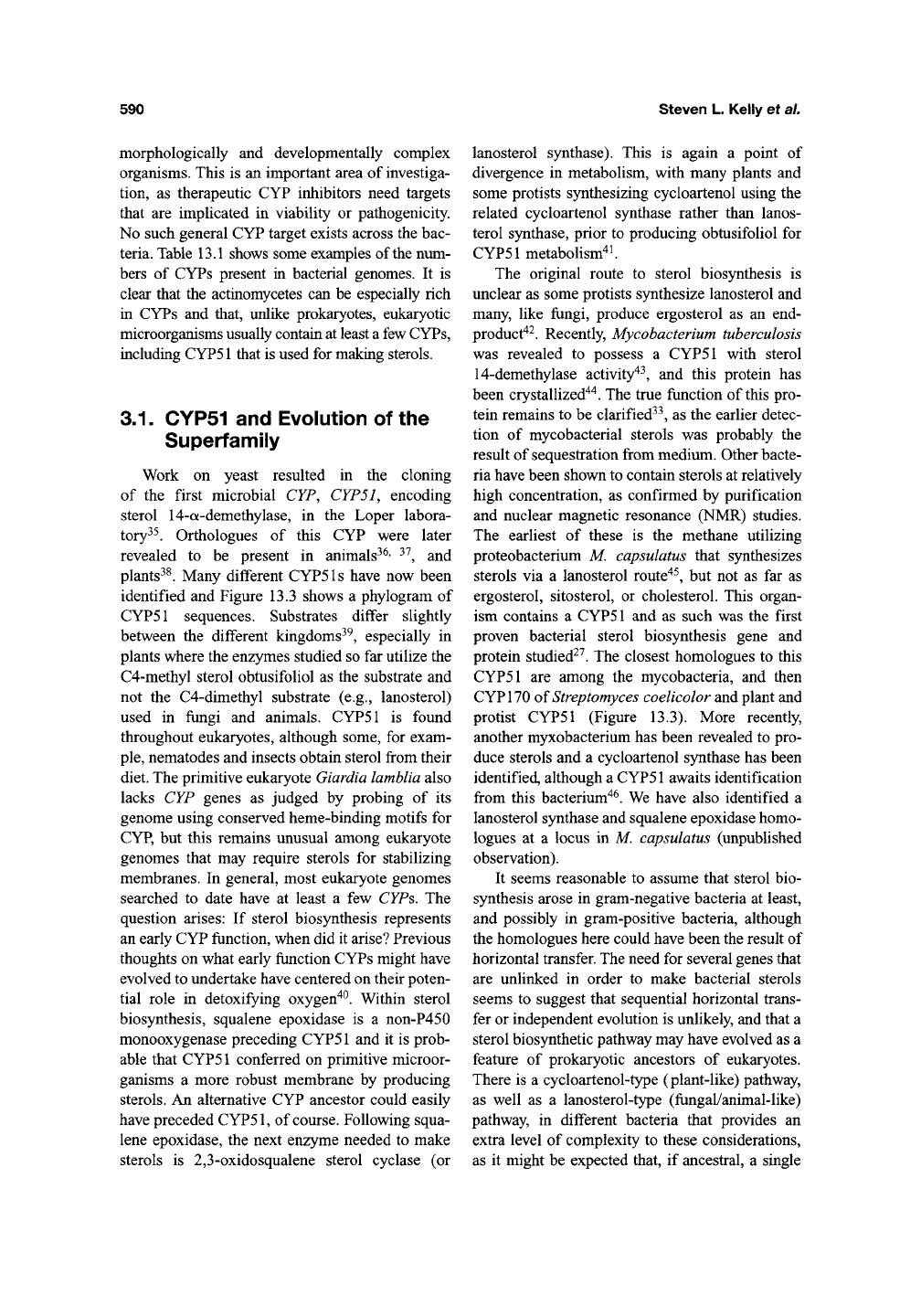
590
Steven L. Kelly et al.
morphologically and developmentally complex
organisms. This is an important area of investiga-
tion, as therapeutic CYP inhibitors need targets
that are implicated in viability or pathogenicity.
No such general CYP target exists across the bac-
teria. Table 13.1 shows some examples of the num-
bers of CYPs present in bacterial genomes. It is
clear that the actinomycetes can be especially rich
in CYPs and that, unlike prokaryotes, eukaryotic
microorganisms usually contain at least a few CYPs,
including CYP51 that is used for making sterols.
3.1.
CYP51 and Evolution of the
Superfamily
Work on yeast resulted in the cloning
of the first microbial CYP, CYP51, encoding
sterol 14-a-demethylase, in the Loper labora-
tory^^. Orthologues of this CYP were later
revealed to be present in animals^^' ^^, and
plants^^. Many different
CYPS
Is have now been
identified and Figure 13.3 shows a phylogram of
CYP51 sequences. Substrates differ slightly
between the different kingdoms^^, especially in
plants where the enzymes studied so far utilize the
C4-methyl sterol obtusifoliol as the substrate and
not the C4-dimethyl substrate (e.g., lanosterol)
used in fungi and animals. CYP51 is found
throughout eukaryotes, although some, for exam-
ple,
nematodes and insects obtain sterol from their
diet. The primitive eukaryote Giardia lamblia also
lacks CYP genes as judged by probing of its
genome using conserved heme-binding motifs for
CYP,
but this remains unusual among eukaryote
genomes that may require sterols for stabilizing
membranes. In general, most eukaryote genomes
searched to date have at least a few CYPs. The
question arises: If sterol biosynthesis represents
an early CYP function, when did it arise? Previous
thoughts on what early function CYPs might have
evolved to undertake have centered on their poten-
tial role in detoxifying oxygen"^^. Within sterol
biosynthesis, squalene epoxidase is a non-P450
monooxygenase preceding CYP51 and it is prob-
able that CYP51 conferred on primitive microor-
ganisms a more robust membrane by producing
sterols. An alternative CYP ancestor could easily
have preceded
CYP51,
of course. Following squa-
lene epoxidase, the next enzyme needed to make
sterols is 2,3-oxidosqualene sterol cyclase (or
lanosterol synthase). This is again a point of
divergence in metabolism, with many plants and
some protists synthesizing cycloartenol using the
related cycloartenol synthase rather than lanos-
terol synthase, prior to producing obtusifoliol for
CYP51 metabolism^i.
The original route to sterol biosynthesis is
unclear as some protists synthesize lanosterol and
many, like fungi, produce ergosterol as an end-
product"^^. Recently, Mycobacterium tuberculosis
was revealed to possess a CYP51 with sterol
14-demethylase activity"^^, and this protein has
been crystallized"^^. The true function of this pro-
tein remains to be clarified^^, as the earlier detec-
tion of mycobacterial sterols was probably the
result of sequestration from medium. Other bacte-
ria have been shown to contain sterols at relatively
high concentration, as confirmed by purification
and nuclear magnetic resonance (NMR) studies.
The earliest of these is the methane utilizing
proteobacterium M. capsulatus that synthesizes
sterols via a lanosterol route"^^, but not as far as
ergosterol, sitosterol, or cholesterol. This organ-
ism contains a CYP51 and as such was the first
proven bacterial sterol biosynthesis gene and
protein studied^^. The closest homologues to this
CYP51 are among the mycobacteria, and then
CYP 170 of Streptomyces coelicolor and plant and
protist CYP51 (Figure 13.3). More recently,
another myxobacterium has been revealed to pro-
duce sterols and a cycloartenol synthase has been
identified, although a
CYPS 1
awaits identification
from this bacterium"^^. We have also identified a
lanosterol synthase and squalene epoxidase homo-
logues at a locus in M. capsulatus (unpublished
observation).
It seems reasonable to assume that sterol bio-
synthesis arose in gram-negative bacteria at least,
and possibly in gram-positive bacteria, although
the homologues here could have been the result of
horizontal transfer. The need for several genes that
are unlinked in order to make bacterial sterols
seems to suggest that sequential horizontal trans-
fer or independent evolution is unlikely, and that a
sterol biosynthetic pathway may have evolved as a
feature of prokaryotic ancestors of eukaryotes.
There is a cycloartenol-type (plant-like) pathway,
as well as a lanosterol-type (fungal/animal-like)
pathway, in different bacteria that provides an
extra level of complexity to these considerations,
as it might be expected that, if ancestral, a single
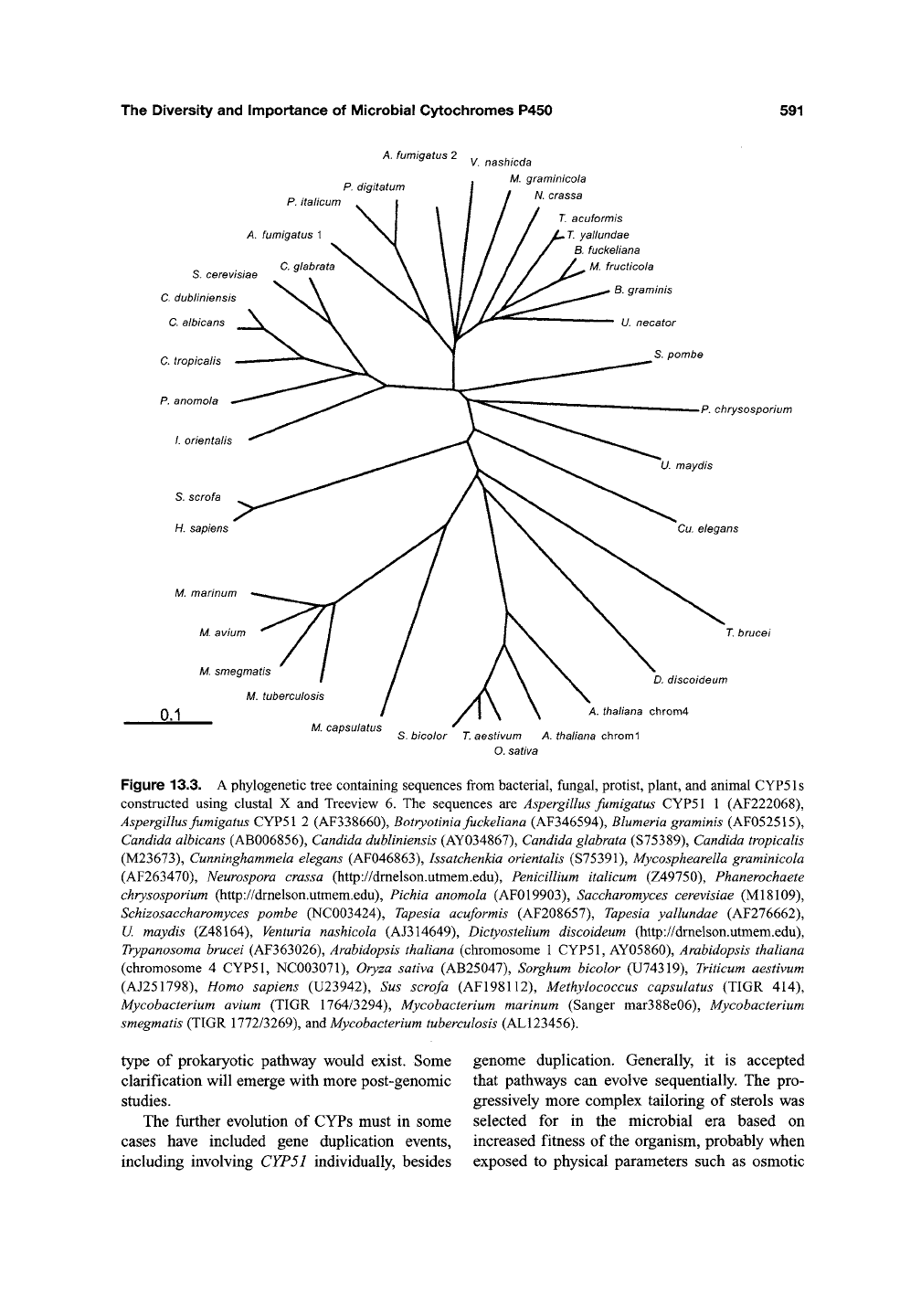
The Diversity and Importance
of
IVIicrobial Cytochromes P450
591
A.
S. cerevisiae
C. dubliniensis
C. albicans
^
C. tropicalis
——
P.
anomola —***"
/. orientalis
'^
S.
scrofa
H.
sapiens
M.
marinum
—
M. avium
p.
p.
italicum
fumigatus
1
C. glabrata
M. smegmatis
j
M.
0.1
tuberculosis
A.
fumigatus
2
digitatum
M. capsulatus
S.
bicolor
V.
nastiicda
M.
graminicola
1 N. crassa
T. aestivum
A.
0.
sativa
T.
acuformis
LmT. yallundae
B. fuckeliana
/
M.
fructicola
^^^^^^
B.
graminis
'
U.
necator
A.
thaliana
. thaliana chroml
S. pombe
*• —P. chrysosporium
U.
maydis
Cu. elegans
T.
brucei
D. discoideum
chrom4
Figure 13.3.
A
phylogenetic tree containing sequences from bacterial, fungal, protist, plant, and animal CYPSls
constructed using clustal
X and
Treeview
6. The
sequences
are
Aspergillus fumigatus CYP51
1
(AF222068),
Aspergillus fumigatus CYP51
2
(AF338660), Botryotinia fuckeliana (AF346594), Blumeria graminis (AF052515),
Candida albicans (AB006856), Candida dubliniensis (AY034867), Candida glabrata (S75389), Candida tropicalis
(M23673), Cunninghammela elegans (AF046863), Issatchenkia orientalis (S75391), Mycosphearella graminicola
(AF263470), Neurospora crassa (http://drnelson.utmem.edu), Penicillium italicum (Z49750), Phanerochaete
chrysosporium (http://drnelson.utmem.edu), Pichia anomola (AFO19903), Saccharomyces cerevisiae (Ml8109),
Schizosaccharomyces pombe (NC003424), Tapesia acuformis (AF208657), Tapesia yallundae (AF276662),
U.
maydis (Z48164), Venturia nashicola (AJ314649), Dictyostelium discoideum (http://drnelson.utmem.edu),
Trypanosoma brucei (AF363026), Arabidopsis thaliana (chromosome
1
CYP51,
AY05860), Arabidopsis thaliana
(chromosome
4
CYP51,
NC003071), Oryza sativa (AB25047), Sorghum bicolor (U74319), Triticum aestivum
(AJ251798), Homo sapiens (U23942),
Sus
scrofa (AF198112), Methylococcus capsulatus (TIGR
414),
Mycobacterium avium (TIGR 1764/3294), Mycobacterium marinum (Sanger mar388e06), Mycobacterium
smegmatis (TIGR 1772/3269),
diwd
Mycobacterium tuberculosis (AL123456).
t5q)e of prokaryotic pathway would exist. Some
clarification will emerge with more post-genomic
studies.
The further evolution of CYPs must in some
cases have included gene duplication events,
including involving CYP51 individually, besides
genome duplication. Generally, it is accepted
that pathways can evolve sequentially. The pro-
gressively more complex tailoring of sterols was
selected for in the microbial era based on
increased fitness of the organism, probably when
exposed to physical parameters such as osmotic
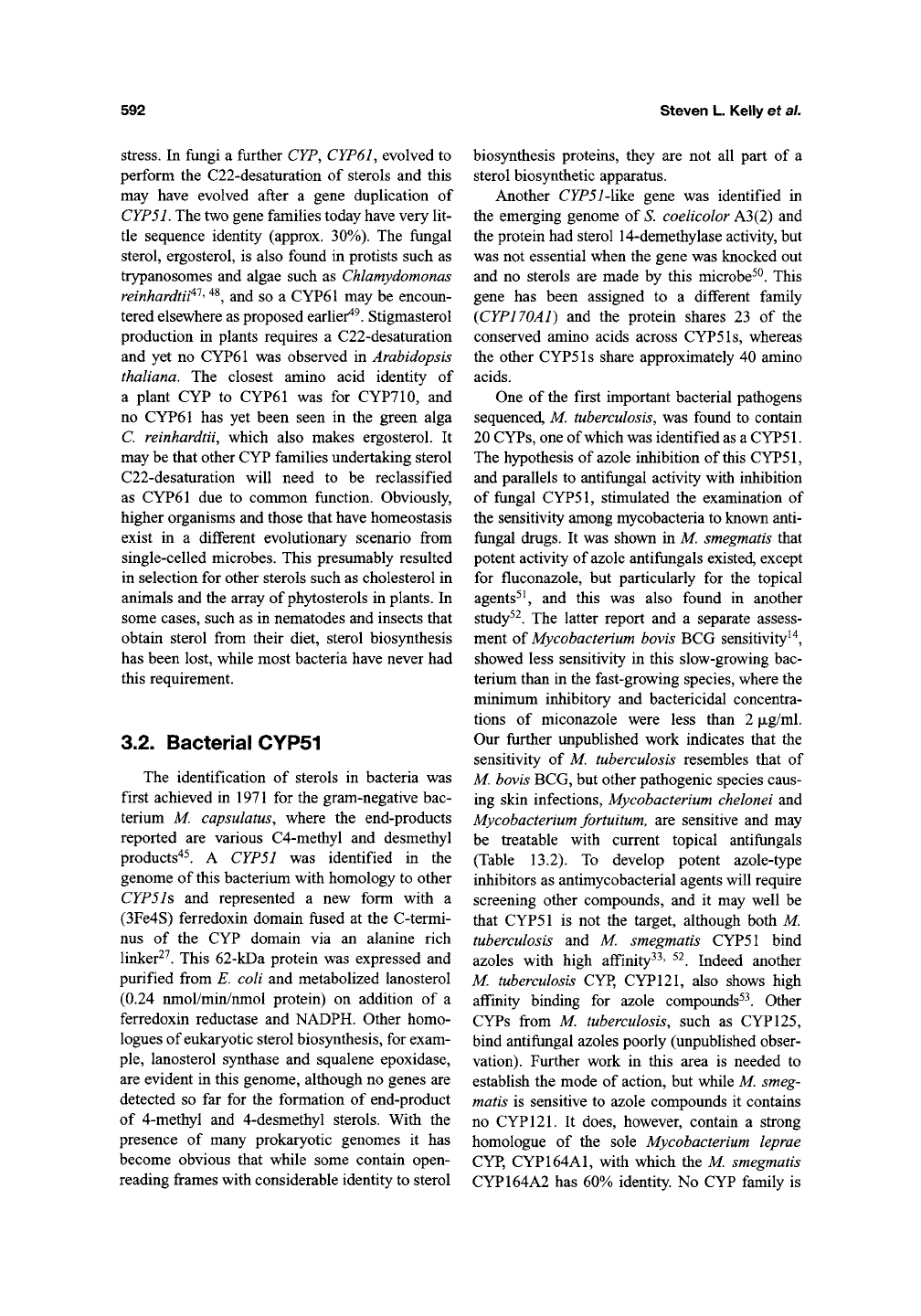
592
Steven L. Kelly et al.
stress.
In fungi a further CYP, CYP61, evolved to
perform the C22-desaturation of sterols and this
may have evolved after a gene duplication of
CYP5L The two gene families today have very lit-
tle sequence identity (approx. 30%). The fungal
sterol, ergosterol, is also found in protists such as
trypanosomes and algae such as Chlamydomonas
reinhardtii^^'
^^,
and so a CYP61 may be encoun-
tered elsewhere as proposed earlier^^. Stigmasterol
production in plants requires a C22-desaturation
and yet no CYP61 was observed in Arabidopsis
thaliana. The closest amino acid identity of
a plant CYP to CYP61 was for CYP710, and
no CYP61 has yet been seen in the green alga
C. reinhardtii, which also makes ergosterol. It
may be that other CYP families undertaking sterol
C22-desaturation will need to be reclassified
as CYP61 due to common function. Obviously,
higher organisms and those that have homeostasis
exist in a different evolutionary scenario fi-om
single-celled microbes. This presumably resulted
in selection for other sterols such as cholesterol in
animals and the array of phytosterols in plants. In
some cases, such as in nematodes and insects that
obtain sterol from their diet, sterol bios3aithesis
has been lost, while most bacteria have never had
this requirement.
3.2. Bacterial CYP51
The identification of sterols in bacteria was
first achieved in 1971 for the gram-negative bac-
terium M capsulatus, where the end-products
reported are various C4-methyl and desmethyl
products'*^. A CYP51 was identified in the
genome of this bacterium with homology to other
CYP5Is and represented a new form with a
(3Fe4S) ferredoxin domain fused at the C-termi-
nus of the CYP domain via an alanine rich
linker^''. This 62-kDa protein was expressed and
purified from E. coli and metabolized lanosterol
(0.24 nmol/min/nmol protein) on addition of a
ferredoxin reductase and NADPH. Other homo-
logues of eukaryotic sterol biosynthesis, for exam-
ple,
lanosterol synthase and squalene epoxidase,
are evident in this genome, although no genes are
detected so far for the formation of end-product
of 4-methyl and 4-desmethyl sterols. With the
presence of many prokaryotic genomes it has
become obvious that while some contain open-
reading frames with considerable identity to sterol
biosynthesis proteins, they are not all part of a
sterol biosynthetic apparatus.
Another CYPSl-Wks gene was identified in
the emerging genome of
S.
coelicolor A3 (2) and
the protein had sterol 14-demethylase activity, but
was not essential when the gene was knocked out
and no sterols are made by this microbe^^. This
gene has been assigned to a different family
(CYP170A1) and the protein shares 23 of the
conserved amino acids across CYPSls, whereas
the other CYPSls share approximately 40 amino
acids.
One of the first important bacterial pathogens
sequenced, M. tuberculosis, was found to contain
20 CYPs, one of which was identified as a
CYP51.
The hypothesis of azole inhibition of
this
CYP51,
and parallels to antifungal activity with inhibition
of fungal
CYP51,
stimulated the examination of
the sensitivity among mycobacteria to known anti-
fungal drugs. It was shown in M smegmatis that
potent activity of azole antifungals existed, except
for fluconazole, but particularly for the topical
agents^ ^ and this was also found in another
study^^. The latter report and a separate assess-
ment of Mycobacterium bovis BCG sensitivity^'*,
showed less sensitivity in this slow-growing bac-
terium than in the fast-growing species, where the
minimum inhibitory and bactericidal concentra-
tions of miconazole were less than 2 |ULg/ml.
Our further unpublished work indicates that the
sensitivity of M. tuberculosis resembles that of
M. bovis BCG, but other pathogenic species caus-
ing skin infections, Mycobacterium chelonei and
Mycobacterium fortuitum, are sensitive and may
be treatable with current topical antifungals
(Table 13.2). To develop potent azole-type
inhibitors as antimycobacterial agents will require
screening other compounds, and it may well be
that CYP51 is not the target, although both M
tuberculosis and M smegmatis CYP51 bind
azoles with high affinity^^' ^^. Indeed another
M tuberculosis CYP, CYP
121,
also shows high
affinity binding for azole compounds^^. Other
CYPs from M. tuberculosis, such as CYP
125,
bind antifungal azoles poorly (unpublished obser-
vation). Further work in this area is needed to
establish the mode of action, but while M. smeg-
matis is sensitive to azole compounds it contains
no
CYP121.
It does, however, contain a strong
homologue of the sole Mycobacterium leprae
CYP,
CYP164A1, with which the M smegmatis
CYP164A2 has 60% identity. No CYP family is

The Diversity and Importance of Microbial Cytochromes P450 593
<
o
I
U
PQ
CM
CO
|2
o
u
00
•2 ^
^-
^
S Zl,
^Q
O
I
^ I
P!
I I
''t (N VO
I
? I S I I
:5 oo
^ s
A
csj rsi in
V V ^ °°
Tt OO (N fJ
A
A
rsi csj »o
vo
>^ <N (^ m
<N V ^ ^
^ A
A
•so ^O /-o \D
V V
<N
"^ -^
A
lisiiiii
s.s
•3 ^
I*
^.S
^
cs 5 iS
o ^ ««
5 O t^
S ^ .2
to o 55
^ S C3
OB
O
C«
O 4>
g - §
_- t> (U
•t-
(U .
Q
W3 (O
S
</,
.^
I
^ ^
05
C3 t?
.S t» (u
^^ §
«t C O
O <U C5
?£
^S
^ .D -S
^ O ?^
-•go
.2
§ §5
^ '^
J
O ^^
§
§1
S
o §
1^^
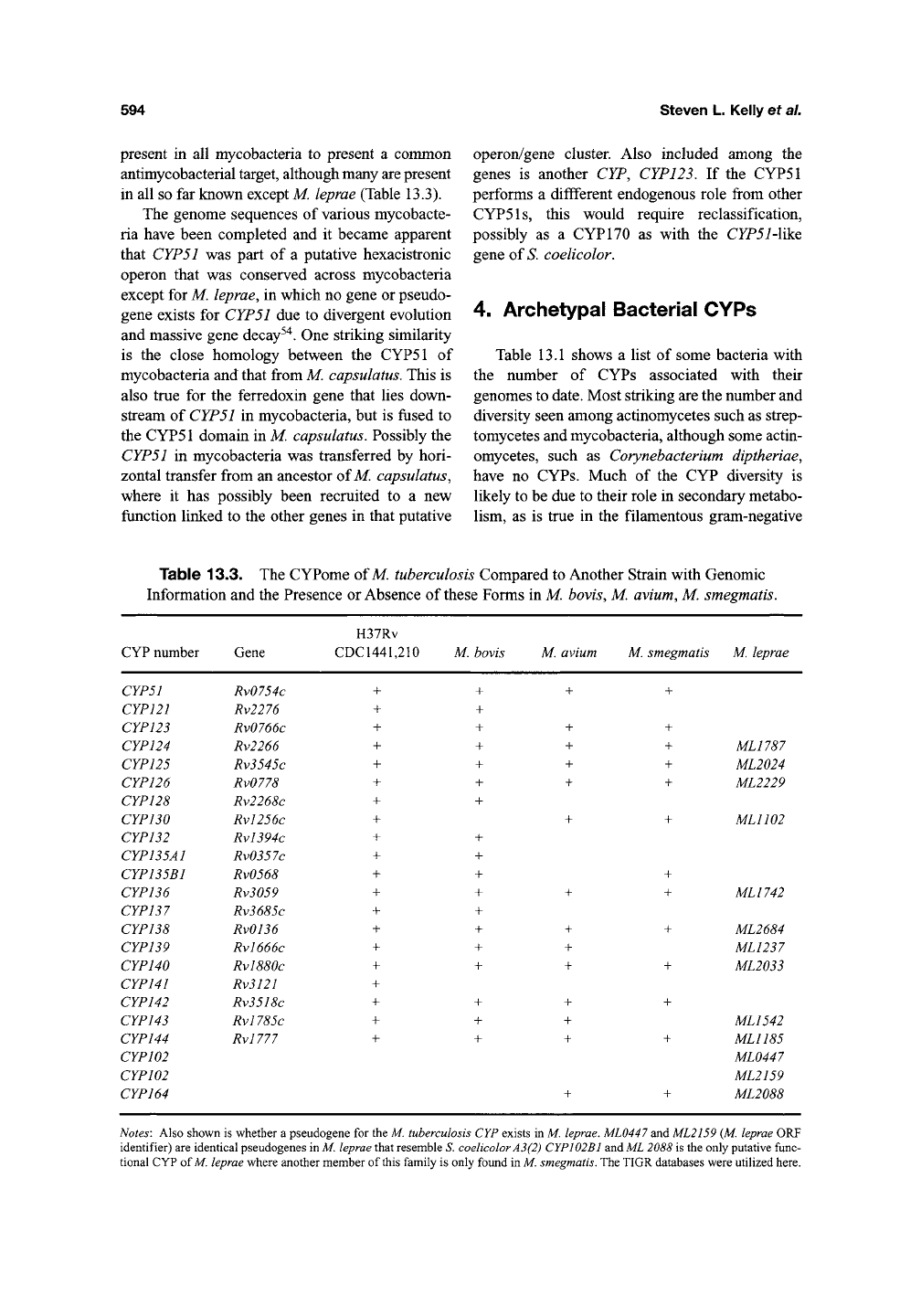
594
Steven L. Kelly et al.
present in all mycobacteria to present a common
antimycobacterial target, although many are present
in all so far known except M leprae (Table 13.3).
The genome sequences of various mycobacte-
ria have been completed and it became apparent
that CYP51 was part of a putative hexacistronic
operon that was conserved across mycobacteria
except for M leprae, in which no gene or pseudo-
gene exists for CYP51 due to divergent evolution
and massive gene decay^"^. One striking similarity
is the close homology between the CYP51 of
mycobacteria and that from
M.
capsulatus. This is
also true for the ferredoxin gene that lies down-
stream of CYP51 in mycobacteria, but is fused to
the CYP51 domain in
M.
capsulatus. Possibly the
CYP51 in mycobacteria was transferred by hori-
zontal transfer from an ancestor of M capsulatus,
where it has possibly been recruited to a new
function linked to the other genes in that putative
operon/gene cluster. Also included among the
genes is another CYP, CYP123. If the CYP51
performs a dififerent endogenous role fi-om other
CYPSls, this would require reclassification,
possibly as a CYP170 as with the CFP57-like
gene of
S.
coelicolor.
4. Archetypal Bacterial CYPs
Table 13.1 shows a list of some bacteria with
the number of CYPs associated with their
genomes to date. Most striking are the number and
diversity seen among actinomycetes such as strep-
tomycetes and mycobacteria, although some actin-
omycetes, such as Corynebacterium diptheriae,
have no CYPs. Much of the CYP diversity is
likely to be due to their role in secondary metabo-
lism, as is true in the filamentous gram-negative
Table 13.3. The CYPome of M tuberculosis Compared to Another Strain with Genomic
Information and the Presence or Absence of these Forms in M bovis, M. avium, M. smegmatis.
CYP number
CYP51
CYP121
CYP123
CYP124
CYP125
CYP126
CYP128
CYP130
CYP132
CYP135A1
CYP135B1
CYP136
CYP 137
CYP138
CYP139
CYP140
CYP141
CYP142
CYP143
CYP144
CYP102
CYP102
CYP164
Gene
Rv0754c
Rv2276
Rv0766c
Rv2266
Rv3545c
Rv0778
Rv2268c
Rvl256c
Rvl394c
Rv0357c
Rv0568
Rv3059
Rv3685c
Rv0136
Rv1666c
Rvl880c
Rv3121
Rv3518c
Rv 1785c
Rvl777
H37Rv
CDC1441,210
+
+
+
+
+
+
+
+
+
+
+
+
+
+
+
+
+
+
+
+
M. bovis
+
+
+
+
+
+
+
+
+
+
+
+
+
+
+
+
+
+
M. avium
+
+
+
+
+
+
+
+
+
+
+
+
+
+
M. smegmatis
+
+
+
+
+
+
+
+
+
+
+
+
+
M leprae
ML1787
ML2024
ML2229
ML1102
ML1742
ML2684
ML 1237
ML2033
ML1542
ML 1185
ML0447
ML2159
ML2088
Notes: Also shown is whether a pseudogene for the M. tuberculosis CYP exists in M. leprae. ML0447 and ML2159 (M. leprae ORF
identifier) are identical pseudogenes in
M.
leprae that resemble S. coelicolor A3 (2) CYP102B1 and ML 2088 is the only putative func-
tional CYP of M leprae where another member of this family is only found in
M.
smegmatis. The TIGR databases were utilized here.
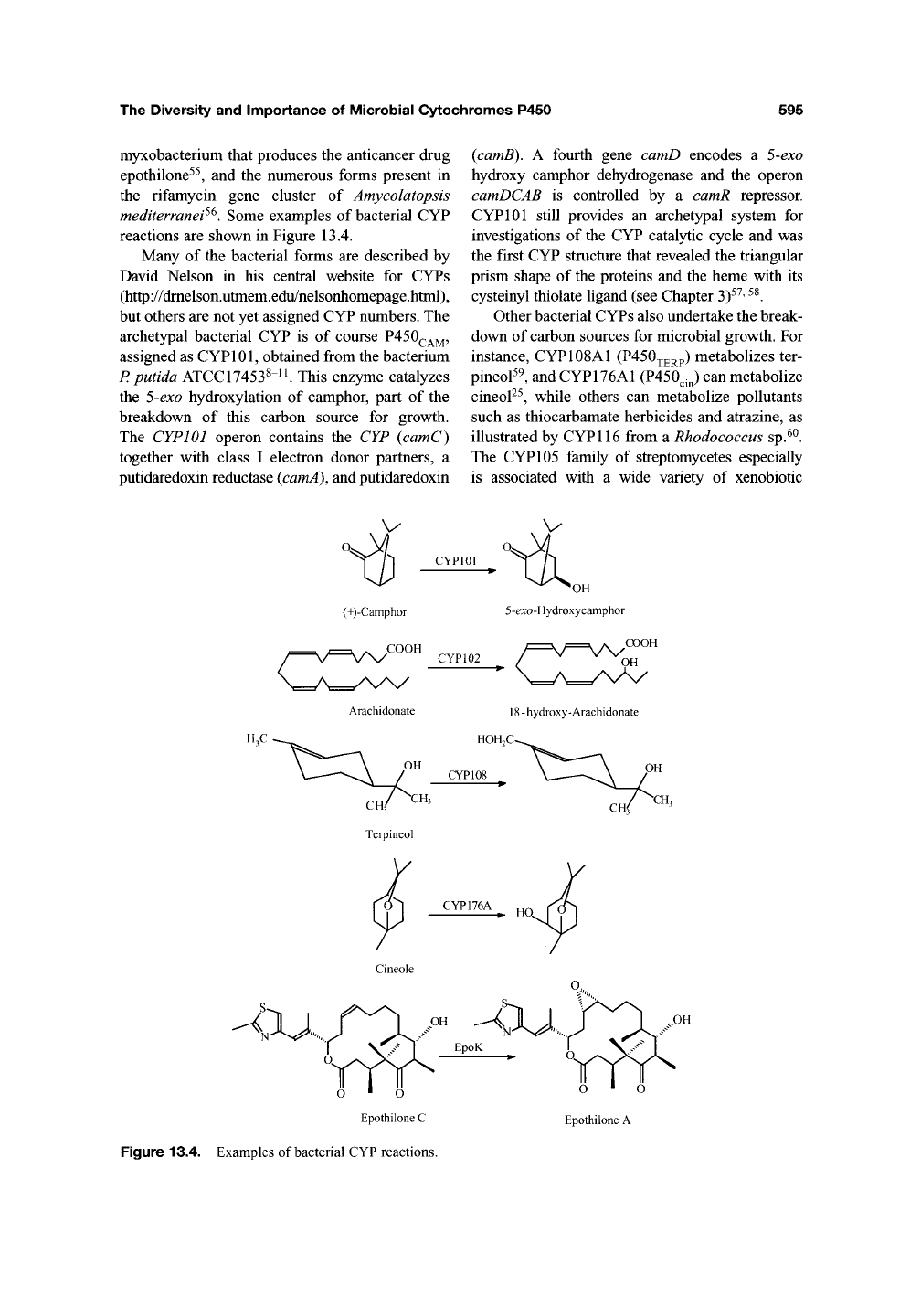
The Diversity and Importance of IS/licrobial Cytociiromes P450
595
myxobacterium that produces the anticancer drug
epothilone^^, and the numerous forms present in
the rifamycin gene cluster of Amycolatopsis
mediterranei^^. Some examples of bacterial CYP
reactions are shown in Figure 13.4.
Many of the bacterial forms are described by
David Nelson in his central website for CYPs
(http://dmelson.utmem.edu/nelsonhomepage.html),
but others are not yet assigned CYP numbers. The
archetypal bacterial CYP is of course P450(^^j^,
assigned as CYPlOl, obtained from the bacterium
P.
putida ATCC17453^"^^ This enzyme catalyzes
the 5-exo hydroxylation of camphor, part of the
breakdown of this carbon source for growth.
The CYPlOl operon contains the CYP (camC)
together with class I electron donor partners, a
putidaredoxin reductase (camA), and putidaredoxin
(camB).
A fourth gene camD encodes a 5-exo
hydroxy camphor dehydrogenase and the operon
camDCAB is controlled by a camR repressor.
CYPlOl still provides an archetypal system for
investigations of the CYP catalytic cycle and was
the first CYP structure that revealed the triangular
prism shape of the proteins and the heme with its
cysteinyl thiolate ligand (see Chapter
3)^^'
^^.
Other bacterial CYPs also undertake the break-
down of carbon sources for microbial growth. For
instance, CYP 108A1 (P450^g^p) metabolizes ter-
pineol^^ andCYP176Al (P450^J can metabolize
cineol^^, while others can metabolize pollutants
such as thiocarbamate herbicides and atrazine, as
illustrated by CYPl
16
from a Rhodococcus
sp.^^.
The CYP 105 family of streptomycetes especially
is associated with a wide variety of xenobiotic
(+)-Camphor
V
'OH
5 -exo-Hydroxy camphor
OOOH
^^^^v^"°°"
CYP,02 Z^^^^^T
Arachidonate
OH
18 -
hydroxy-Arachidonate
HOHnC^
CYP 108
'CH3
CH(
OH
•CH,
CYP176A
Cineole
^PU.
^ULJ
o • o
Epothilone C
J^^
Figure 13.4. Examples of bacterial CYP reactions.
